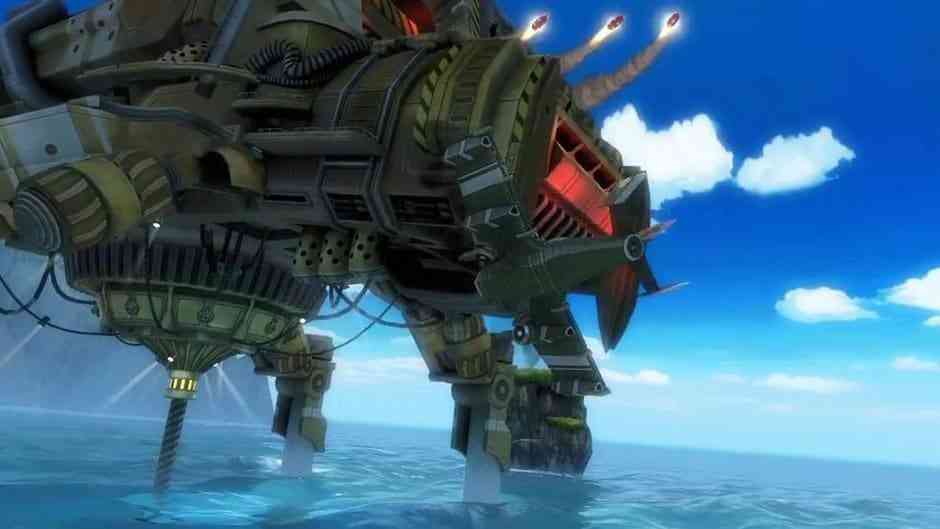Sine Mora is a modern take on the classical 2D shoot ‘em up (shmup), Bullet Hell style. You control a variety of dieselpunk airships through a number of challenging levels and epic boss battles.
In a generation where many games are criticised for being “too easy,” and where highly graphical 3D environments are the benchmark, Sine Mora throws the rulebook out the window. The games is essentially 2.5D, as all the gameplay is 2D in a sidescroller style, but the environments and cut scenes are in 3D and you often “turn a corner” mid level. Despite the 2D nature, it is still a very nice looking game. If you look into the concept art you can see that it is very closely matched by the final renders.

The effects on all the bullets (there are a LOT of them) are impressive and eye catching, which helps as you really do need to notice them to stay alive.
The gameplay differs slightly from the normal shmup style, and simply avoiding the carnage of bullets is not enough. The whole story of the game is based on the characters being able to control time, and your special ability during story mode is a time-slow-down power which is again helpful in trying to avoid the onslaught of projectiles heading your way. Each stage has very tight time limit, and with every hit you take you will lose some of this time. To counter this, every enemy that you hit adds time to your clock, so you are encouraged to destroy as many enemies as you can. As you destroy them, various power ups are dropped. Some of these also add time to your clock, while others improve your weapon, refill your slow-down ability or fill your sub weapon gauge. Take a hit however, and you will lose your collected main weapon upgrades, forcing you to scramble around the screen trying to quickly regain these.
One of the nicest modernisations of the game is the fact it utilises the analogue control sticks over the classical D-pad approach, giving you a bit more control of your movement around the screen, which is particularly useful in boss battle where the projectiles have intricate patterns to dodge.
The boss battles themselves were designed by Mahiro Maeda, best known perhaps for the anime sequences of the Kill Bill movies, and every single one of them epic. Make sure your have collected all the power ups possible and saved your sub weapons for these guys. You will find yourself repeating them several times until you learn the patterns. And once you have defeated each boss, you will unlock it in one of the games other modes: Boss Battles, where you can perfect your technique further.
The story itself is told mainly between levels, though there are some subtitled character interactions during the gameplay cut sequences. They are subtitled as the entire games voice acting is in the developers native tongue of Hungarian. The parts between levels are a lot of reading, and while the story is fairly interesting, it doesn’t really have an effect on the gameplay and you can safely say “tl;dr, press A to skip.”
If story mode wasn’t challenging enough for you, there are also Arcade and Score Attack modes which each ramp up the difficulty even further. The advantage these modes have is that you can pick your plane, character and level (once you’ve unlocked them in story mode) and that in these modes the story and voice overs are left out. The customisation choices set you on a different “node” of which there are over 60 possible combinations. Arcade mode gives you only 3 continues (story mode has 8 on Normal, 5 on Insane), and in Score Attack you get no continues as you play just for the high score. I can’t really say much more about Score Attack mode as I didn’t once make it past the first boss!
Not only is the gameplay itself challenging, but the achievements prove just as difficult, bar one. Just looking at the achievement list on the dashboard doesn’t give you much clue as to how difficult, but you can look at the criteria for each in the main menu, which include spending X amount of time at different score ranks, finding weak spots on bosses and of course, killing so many enemies.
A final note should be made about the sound of the game, though in the blur of gameplay you might miss it, the background music and sound effects are all fantastic, and the title music really sets the theme of dieselpunk.
Sine Mora has to be the best shmup of this generation for 3 reasons: it’s fantastic visual appeal; it’s unique take on gameplay by using time instead of health; and it’s incredible level of difficulty. Well done Digital Reality and Grasshopper Manufacture. Well done.
9 slow motion Bullet-Hell screens out of 10
